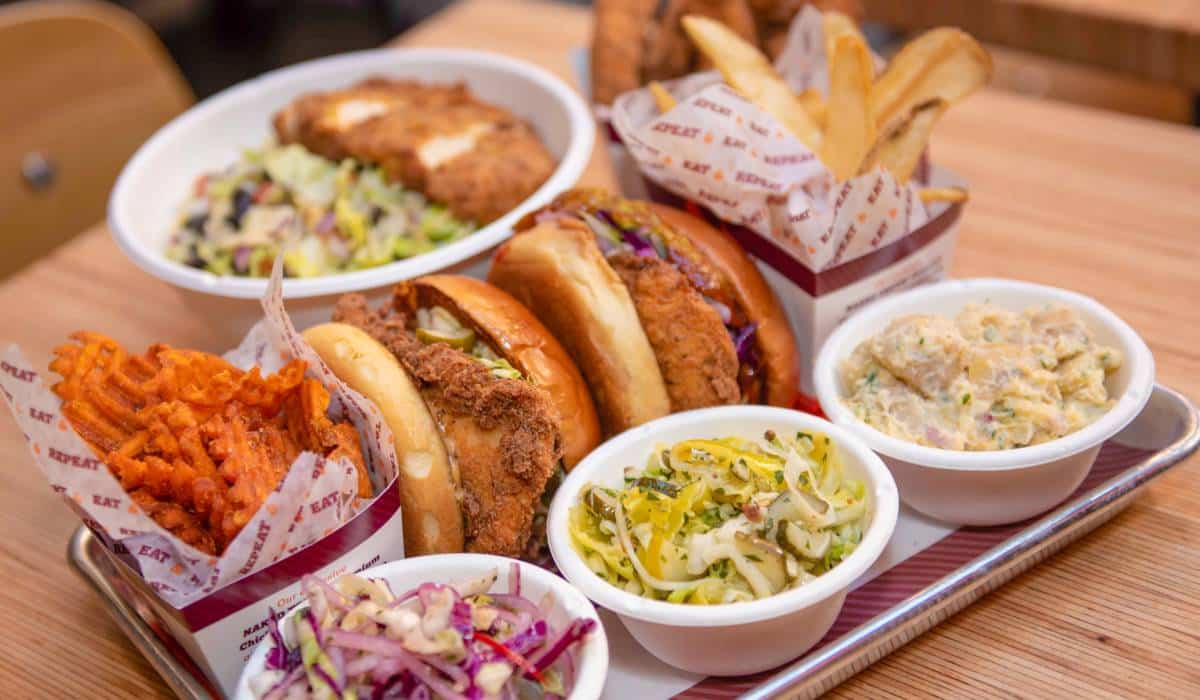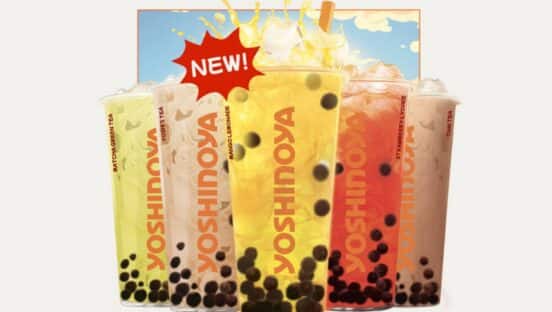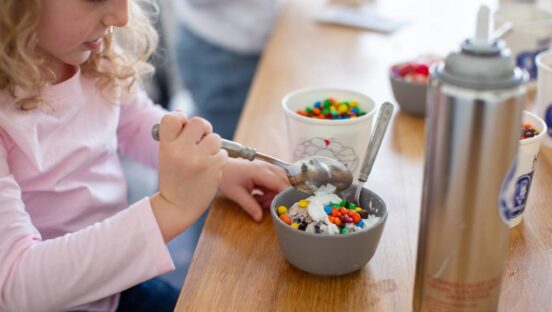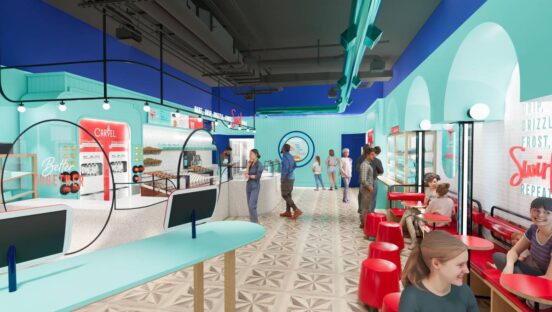Big Chicken CEO Josh Halpern knows he’s holding a different deck than most upstart fast casuals. His ace stands 7-foot-1, 300-plus pounds, and is one of the most recognizable human beings to walk the globe. But this is a well-worn story in the restaurant business. Many concepts, from steakhouses to virtual chains, have latched their fortunes to famous figures, with varying degrees of success. Where they’ve generally gone wrong, however, is exactly what Halpern circled as a Big Chicken differentiator: “We’re so committed to the quality of this food because we know people only come one time for Shaquille [O’Neal], and that’s a long-term losing proposition,” he says.
Halpern and the NBA legend and entrepreneur (as well as fast–food franchisee and Papa Johns board member) haven’t had any trouble generating interest in Big Chicken. Founded in 2018 as a three-pronged venture between Authentic Brands Group, JRS Hospitality, and O’Neal, growth began to dial up in 2021. At the time, there were two brick-and-mortar locations in Los Angeles and Las Vegas, and another nontraditional spot on Carnival Cruise Ship Mardi Gras.
READ MORE: Shaq’s Big Chicken and Blue Origin Join Forces on Dream to Pursue Restaurant in Space
Halpern, most recently a chief sales officer for brewing company FIFCO USA, was brought in that May to guide Big Chicken’s next act. Today, there are 16 units open, about a 3X bump, year-over-year. Six more are slated by quarter’s end, with future growth targeted for Florida, Texas, Oklahoma, Chicagoland, Washington, Nevada, Arizona, Utah, Idaho, Nashville, and Greater Los Angeles.
Halpern says Big Chicken could add 20 total additional stores this year. But really, the only things slowing its path are the same external forces slogging development industrywide, such as the fact timelines from contract signing to opening have ballooned to 12–18 months from nine to 12 months due to constructing and permitting delays.
“We have franchisees up and down right now, in LOI, signing leases, stores beginning under construction planning, etc,” he says. “And then we have franchisees doing a lot of looking. … There’s not as much Grade A real estate out there currently and, on top of it, supply chain building materials and stuff has been constrained. Things are taking a little longer than they used to take. A lot of the deals that were signed last year are now starting to bear fruit and will bear fruit really throughout this year.”
It’s all relative, though. Big Chicken is moving rather quickly by most standards. Halpern says “franchisees are submitting sites every single week.” It’s more a matter of logistics and navigating macro twists than drumming up demand, which is a good position for Big Chicken to be in, Halpern says.
And going back to the original aim, you can thank Big Chicken’s laurels. “We live by the ethos of people are going to come for the first time because of Shaquille, but they’re not going to keep coming back because of him,” Halpern says. “We need to have such a high quality that you’re proud to walk into Shaquille’s place.”
There’s no “selfie wall” in restaurants. People come in to check out O’Neal’s place but don’t find a museum dedicated to him. Halpern says there’s no cost-cutting on ingredients or anything food or service related. Big Chicken never lets its super-sized persona serve as a crutch for side-stepping great experience.
An example hit the market recently. Halpern saw what he viewed as similar-priced and product-centric brands, like Shake Shack, for one, taking the drive-thru dive. So Big Chicken studied the field and came up with an IT package to launch one at a corporate build in Summerlin, an urban and residential community outside Las Vegas.
It’s a full-tilt, quick-service drive-thru with a speaker box where guests pull around to the window (they can order digitally as well). Big Chicken had two lead questions to address before activating: First, would people be willing to wait in line when food was cooked to order, as it is at Big Chicken? Halpern just had to look across the street at In-N-Out Burger and its double-digit cars wrapped around.
Next, was there a price point guests would leave thinking, “this isn’t a drive-thru concept?” In other words, does it change Big Chicken’s value proposition to get into the channel? “But then we’re looking around seeing Shake Shack’s success, Chipotle’s success, companies that are very much in the same price point as us being successful with drive-thru,” Halpern says. “And we just reached the conclusion that the drive-thru consumer has evolved into something very different than when we were kids and it was more of a traditional, [quick-service restaurant] approach.”
The unit has supported that sentiment to date, generating about 40 percent mix or so in drive-thru sales. Even with the lift, Halpern doesn’t see dine-in ever leaving the Big Chicken footprint. Again, returning to its core equity, customers walk in seeking an authentic connection to O’Neal, and then discover a menu they’ll be loyal to for a lifetime. The best place to do so will always be within the four walls.
Still, there’s potential to open further accessibility (a loyalty program is coming). Halpern says Big Chicken launched drive-thru at a corporate venue to figure out how the check list changed compared to a traditional restaurant. It had to optimize for a different set of questions. A key friction point, given there’s not 7,000 Big Chickens like there are Taco Bells, is guests are still learning the menu. So the brand needed the drive-thru order taker to be prepared to walk diners through the menu just as if they were at the counter.
There are fresh stakes, too. If a drive-thru customer leaves without utensils or sauce, etc., it becomes a much larger issue than if they were sitting down inside. “I think it’s really a notion of when do you bring the in-restaurant experience to the drive-thru and also what steps do you need to take at the drive-thru window itself to make sure the guest has a really great, satisfying experience,” Halpern says.
These are ticks Big Chicken will work through. One of its outset beliefs, Halpern adds, is any major prototype in the system will be taken on by corporate first. They want to understand the risks before asking franchisees to take them on their behalf, he says. This unit was Big Chicken’s third corporate store, with no plans for more at this time (it’s all franchisee expansion on deck).
“We’ve had numerous franchisees already come out to evaluate the place, see the operations, stand by the window to understand what’s going on. And we are going to begin approving more sites with drive-thru windows moving forward,” Halpern says.
Another recent first was breakfast. The menu debuted at the same opening, with items like a Nashville Hot Burrito and a coffee lineup from La Colombe. The test was a response to “multiple” requests from airports asking to get into the daypart. Big Chicken just launched in Kansas City International Airport’s new terminal. “We wanted to stay true to what Big Chicken stands for, which is big food, big flavor, big fun,” Halpern says. “We wanted to stay true to the notion of each dish having a connection back into Shaquille’s life, and that’s really what we sought to build.”
As Big Chicken has scaled, it hasn’t featured just one hero item for each market. Flavors and top orders have reflected regional trends, which Halpern believes bodes well for where future innovation can take the chain. And, also, another sign Big Chicken’s culinary-first DNA is being recognized by customers beyond the trial visit; people aren’t showing up for one, famous item and never coming back; they’re making the menu their own.
For instance, in Ohio, a state known for its savory preferences, the No. 1 sellers are are the Big & Sloppy (mac and cheese, crispy fried onions, roasted garlic barbecue aioli) and Crispy Chicken Grilled Cheese (three cheeses, chipotle barbecue sauce, rustic Italian bread). In New York’s UBS Arena, home to the Islanders, a custom Buffalo sandwich was the top hitter (a Northeast preference for hot). The Nashville Hot Chicken Uncle Jerome, meanwhile, reigns in Las Vegas.
“We’re completely OK with the fact that the No. 1 sandwich in Ohio and the No. 1 sandwich in Las Vegas are going to be completely different,” Halpern says.
As a refresher, JRS’ Matthew Silverman and Matthew Piekarski, are two “world-class chefs,” in Halpern’s words. It took six months just to get the breading right. For beverages, the culinary team used more than 50 gallons of milkshake mix before finding the right Southern vanilla blend.
Expect to see more Big Chicken spots in arenas going forward. O’Neal’s sports clout and the brand’s handheld lineup are a natural fit. It’s currently in Arizona’s ASU Mullett Arena, Baltimore’s CFG Bank venue, Texas’ Moody Center, and Seattle’s Climate Pledge Arena. The first MLB stadium store is coming later in the quarter. “They’re very high velocity for us, we get huge lines for our food and it’s really a great way for people to understand and try our product,” Halpern says.
Also on the slate going forward–international expansion. Halpern says that initiative will launch end of year “to at least one, if not, two or three countries.”
“We’re continuously going to test the boundaries of the brand and what the brand can achieve. But we really continue to go back to good value for your money, big meal, good value for your menu, and accessibility. And those have always been our values and they’re going to be our values in addition to continuous improvement. We’re always going to be looking at how to better the brand.”








